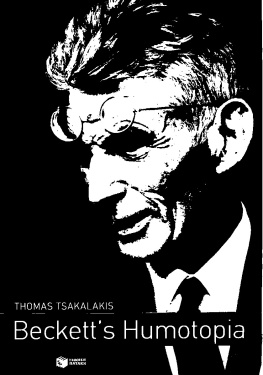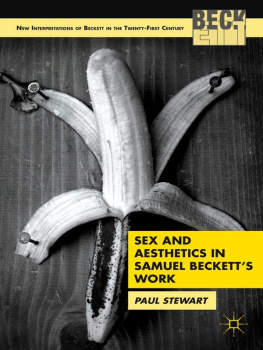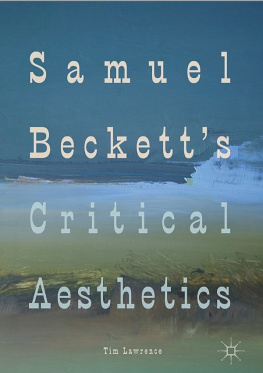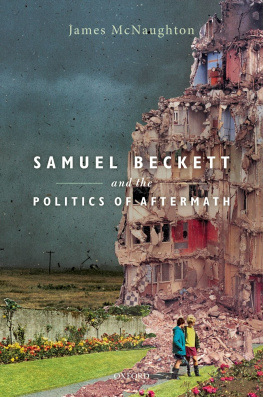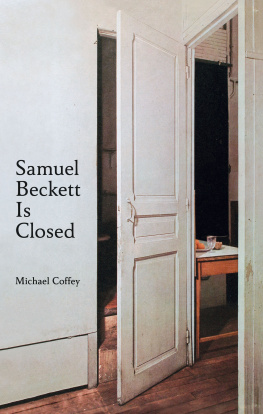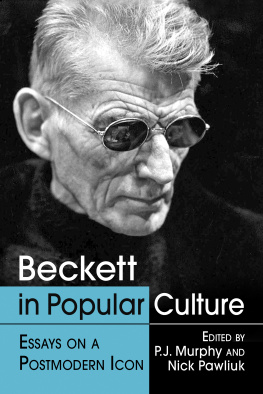BECKETTS FILM :
A POLYCENTRIC PARODIC PICTORIAL PARABLE
FOR PERENNIAL PARADOXES
Thomas Tsakalakis
ABSTRACT
We put forth the proposition that Becketts Film adroitly parodies Russells paradox in order to call into question the normative claims of metaphysical posturing and to disrupt the prevalent philosophical paradigms. Film instantiates the pitfalls of dogmatic certainties by dint of humor, which is the sole set that contains itself.
At the epicenter of the design of Stephen Hawkings The Grand Design there are grand epistemological and ontological conundrums, as evidenced by the questions Hawking poses right off the bat: How can we understand the world in which we find ourselves?, What is the nature of reality? or Did the universe need a creator? (5). It is a philosopher, Nietzsche, who first proclaimed the demise of (a shared belief in) God. It is a scientist, Hawking, who embarks upon an endeavor to answer the aforementioned questions by stipulating that only scientists be assigned this task, as philosophy (ontotheology would have been more precise in this context) is dead owing to the fact that it has not kept up with modern developments in science, particularly physics (5), and he arrives at the conclusion that the primum movens is not God, but gravity (180). It is a literary figure (erudite in both philosophy and science), Beckett, who accords emphasis to the fallacies inherent in the interpretations executed by the trifecta, namely philosophy, science and literature. We contend that Film is the work wherein Becketts humotopia , an immanent topos at one remove from immanence, with humor as its emergent property [] whose contingent flux reflects the differentiated multiplicity which is the resultant of the interactions between concretely existent human beings, attains its apogee (Tsakalakis, 7). We pursue the hypothesis that Beckett proffers a cinematic variation on Bertrand Russells paradox, which pertains to the problematic character of the set of all sets that are not elements of themselves, inasmuch as its a member of itself if and only if its not a member of itself (Goldstein, 91). Beckett thereby stages a parodic game wherein the object/subject of the movie is the self-perception of a bifurcated subject/object, which is to say that the camera, qua a Panopticon, is substantialized as an active subject (E), whereas the assumed subject (O) is both de-subjectified and objectified via an intersubjective perception that occurs within a framework delimited by a concatenation of recursions.
Becketts atypical anti-ocularcentrim takes many shapes. Martin Jay explicates how the advent of perspective in art during the Renaissance, and the attendant denarrativation of the ocular (51), led to a
rationalization of sight (49). Film sternly contradicts the naturalistic conventions of linear perspective; in the movie, the outlook may be perspectivist but the vision is anything but perspectival insofar as depth
perception is rendered unattainable on account of Os (and Es) monocular vision; and the photographs eloquently narrate the adventures of ir rational sight. Aside from the fact that Beckett specifies that the goings-on of the film take place in the period about 1929 (1967, 164), the year Un chien andalou was released, there may also be an intertextual affinity between the opening scenes of the two short movies (see Brater, 76); yet Beckett does not slice through the eye as Buuel and Dal, and also Descartes, while working on his La Dioptrique (Jay, 75) had done. Applicable to the point at issue is Rudy Ruckers notion of the hypersphere, which he introduces in his exploration of spatial infinities: The reason that the two-dimensional surface of the Earth is finite but unbounded is that it is bent, in three-dimensional space, into the shape of a sphere. In the same way, it is possible to imagine the three-dimensional space of our universe as being bent, in some four-dimensional space, into the shape of a hypersphere (17). Rucker correctly indicates that the precursor of this concept is a saying ascribed to Hermes Trismegistus: God is an intelligible sphere whose center is everywhere and whose circumference is nowhere (17). It is well-established long before Borges incorporated this as a recurrent theme in his oeuvre that, more often than not, deities are orbicular. In light of the above, Film s unconventional anti-ocularcentrism can perhaps be seen as follows: given that God and the eye share the same bulbous shape, it might not be entirely unreasonable to hypothesize that, by shunning all eyes, even things that look like eyes (for instance, the holes in the rocking chairs headrest), O essentially denounces God. We are here intentionally replicating a theoretical framework wherein all viewpoints can be taken as fractals, all self-similar and all subdivisions of the grand design (to quote Hawking) or of the infinite one. Our aim is to deconstruct this framework by explaining why Film cannot be construed as a hymn to objective idealism or to the univocity of being (we will expand on that later). The fact that O is not content merely to tear the print of God the Father from the wall, but he then tears it in four, throws down the pieces and grinds them underfoot (Beckett 1967, 167), may be a telling clue to his wrath against God. We are made to infer that this rage stems from the heinous aftermath of World War I, during which he must have lost both his family and his left eye until the sixth photograph, wherein he appears newly enlisted (Beckett 1967, 174), O does not wear a patch. It is irrefragably worth pointing out that O is smiling in all of the pictures except for the first two, in which he is in his mothers presence (Beckett 1967, 173), and the last one, where his grim expression (Beckett 1967, 174) reveals his indignation at the divine hypersphere, Gods dispassionate eye, which is invariably indifferent to his woes.
Within the same exegetical schema, it may be argued that the films universe is bent in the duoverse (Rucker, 21) of the readers/spectators, where it is received and processed by their ocular hypersphere. Perhaps it would not be exceedingly daring to suggest that, on this plane, it is we, the readers/viewers, who assume the role of the unconcerned God. As detached observers, we probably adopt the same facial expression Beckett assigns to E in the final scene, neither severity nor benignity, but rather acute intentness (1967, 169; emphasis in the original). Irrespective of what benefits we seek to reap from watching Film , either we attempt to assuage our ennui or we play our parts as cultured individuals, it is certain that we cannot extricate O from his comitragic plight; in all likelihood we would not, even if we could, because if we did, there would be no movie for us to watch (at least not the same one). Hence, in a way, our ineluctable apathy exacerbates Os predicament. Further, E is equally exposed to our phlegmatic gaze. In the final scene, we stare at him staring at O, but neither do we sing his praises nor do we mete out punishment upon him. In the viewers four-dimensional hypersphere there are infinite three-dimensional universes (the two-dimensional screen/page bent into the shape of a sphere) like the one in the movie, to wit alternative histories, multiple different ways the plot could have unfolded.
Nonetheless, this multiverse concept (Hawking, 136) knows no limits; one may theorize about duoverses, triverses and so forth, based on one of the Universal Laws in the Emerald Tablet, the Hermetic principle, As above, so below (Rucker, 22), which stands for an overriding commitment to the univocity of being. We are attuned to the reverberations of Blakes Auguries of Innocence: To see a World in a grain of sand, / And a Heaven in a wild flower, / Hold Infinity in the palm of your hand, / And Eternity in an hour (15). At this point, we are confronted with the hoary ontological problem of the One and the Infinite (or of monism versus pluralism by way of dualism), which is not that different from a Strange Loop, a phenomenon that emerges whenever, by moving upwards (or downwards) through the levels of some hierarchical system, we unexpectedly find ourselves right back where we started (Hofstadter 1979, 10). Rucker, a proponent of theomonistic mysticism, adheres to the notion that the One and the Many are really the same (217), and he seeks to buttress his argument by quoting from Georg Cantor, the mathematician who put forth the so-called nave (as opposed to axiomatic) set theory: A set is a Many that allows itself to be thought of as a One (qtd. in Rucker, 40). A conjecture
Next page

